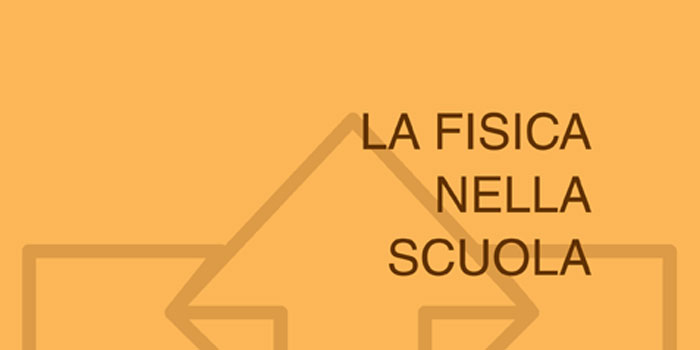Articoli rivista
Note di laboratorio
 Anno XLIX - n.2 - aprile/giugno 2016
Anno XLIX - n.2 - aprile/giugno 2016 La relazione tra potenza e velocità nel ciclismo
This paper is a summary of a project prepared by an Italian student for the final State exam of Liceo Scientifico. The aim of the work is to understand fluid friction and rolling resistance involved in cycling. A simple physical model has been developed and it has been subsequently compared with experimental data collected by a tachometer and a power meter. […]
 Anno XLVII - n.4 - ottobre/dicembre 2014
Anno XLVII - n.4 - ottobre/dicembre 2014 La statistica con la macchina di Galton
This work proposes an example of experimental approach for the treatment of statistic matters for last classes of the secondary school. Through the construction of Galton’s machine, the validity of the central limit theorem has been shown and as the distribution of the random experimental data is described to the best by the Gauss’curve. […]
 Anno XLIX - n.1 - gennaio/marzo 2016
Anno XLIX - n.1 - gennaio/marzo 2016 La suscettività magnetica al variare della temperatura
We present an experiment to measure the temperature dependence of magnetic susceptibility of a dia-magnetic material such as pyrolityc graphite. Pyrolityc graphite is a typical diamagnetic material and can levitate in a strong magnetic field. the levitation height was changed by varying the pyrolityc graphite temperature using a lighter. […]
 Anno XXIII - n.4 - ottobre/dicembre 1990
Anno XXIII - n.4 - ottobre/dicembre 1990 La valutazione dell’ingrandimento angolare negli strumenti ottici
This paper analyses an experimental method by which laws of angular magnification, for common optical instruments, are pointed out. Kepler’s and Galilei’s telescopes simple and compound microscopes are analysed with the aid of a TV camera and a monitor. Image sizes are measured on the monitor before and after instrument magnification; […]
 Anno XXIX - n.2 - aprile/giugno 1996
Anno XXIX - n.2 - aprile/giugno 1996 La velocità della luce
A short history of the measurement of the velocity of light from Galileo to our days. with particular reference to Foucault’s method, which has been used in an experiment for didactic purpose. […]
 Anno XLV - n.3 - luglio/settembre 2012
Anno XLV - n.3 - luglio/settembre 2012 Laboratorio di Microscopia a Scansione attuato via Internet: una esperienza nel Progetto Lauree Scientifiche a Padova
Using an educational SPM driven by a PC that supports a VNC-server and a motorized webcam we set up an internet controlled RemoteLab SPM. Trained highschool students supervised by their teachers selected the sample to be analyzed, controlled the PC that drove the SPM and performed the measurements and the image analyses in remote mode. […]
 Anno XLVI - n.2 - aprile/giugno 2013
Anno XLVI - n.2 - aprile/giugno 2013 Laboratorio didattico controllato in remoto
Remotely controlled laboratories (RCL) allow a user to connect from place A to a real experiment carried out in place B. These experiments can be carried out without booking and without needing to download special software. Describing the details of an experiment we give an example of the working principle of this technology […]
 Anno XLIX - n.1 - gennaio/marzo 2016
Anno XLIX - n.1 - gennaio/marzo 2016 L’ipotesi della natura elettromagnetica della luce e la valutazione “classica” della sua velocità
Retracing the steps which led to formulate the hypothesis on electromagnetic nature of light, two circuits (RL, RC) in alternating current regimen were observed to measure the constants of vacuum permeability and permittivity, yielding μ0 = (1,27 ± 0,51)·10−6 H/m, […]
 Anno XXV - n.3 - luglio/settembre 1992
Anno XXV - n.3 - luglio/settembre 1992 Lo spessore del segno di una matita
In this note is described a very simple experiment to estimate the thickness of the graphite layer deposited on paper by a writing pencil. […]
 Anno XXX - n.2 - aprile/giugno 1997
Anno XXX - n.2 - aprile/giugno 1997 Lo spessore di una bolla di sapone
Measuring the thickness of a soap bubble is an intriguing problem that can be solved – at least with respect to the order of magnitude – with scales of 0.01 grams sensitivity (or better). Solving this problem at secondary school level and up is a motivating activity that requires the students to concretely exercise their inventiveness. […]
 Anno XXIX - n.4 - ottobre/dicembre 1996
Anno XXIX - n.4 - ottobre/dicembre 1996 Magia con la luce
This note describes an alternative classroom demonstration of Newton’s classic method to mix, by means of a prism, rainbow colours to get white light again. […]